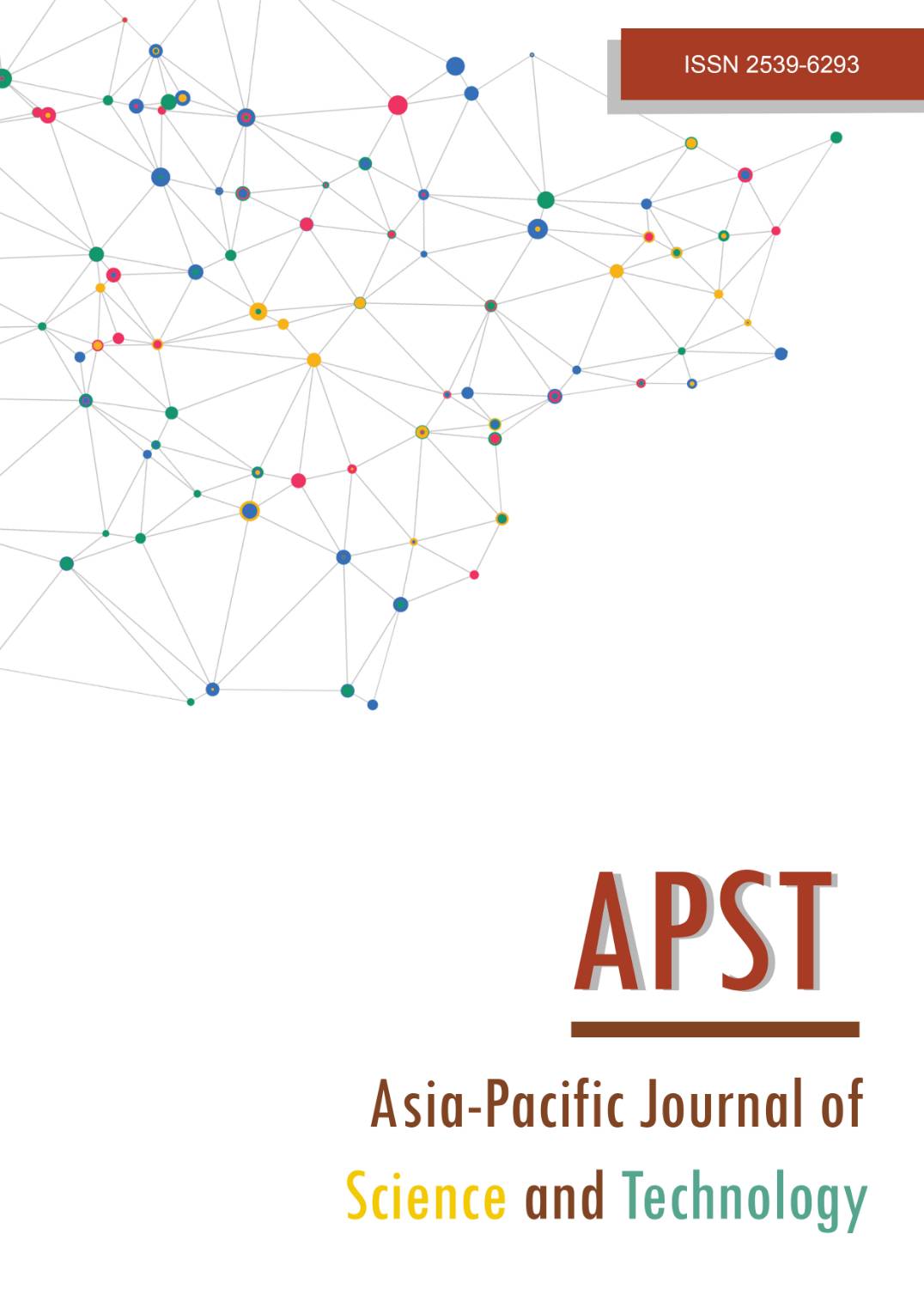Microbial decomposition of longan leaf: I. physico-chemical and biological changes during composting
Main Article Content
Abstract
Longan is an economic fruit crop of Northern Thailand. Incineration of longan residues from pruning is practiced, leading to environmental pollution. The more sustainable way is to convert the wastes into compost. In this study, therefore, composting of longan leaves was performed to monitor changes in physico-chemical and biological properties. There were three treatments including 1) longan leaves+cow dung (LC), 2) rice straw+cow dung (RC) and 3) longan leaves+rain tree leaves+cow dung (LRC). Our results indicated that, at day-120, adding rain tree leaves to longan leaves in LRC provided the lowest C:N ratio (24.2:1) while the highest one was found in LC (40.3:1). The high N applied treatments (LRC and LC) appeared to reach maturity germination index (GI) >80% earlier than that with low N content (RC). Humic acid concentration of RC and LC was around 4 times higher than their initial values, indicating high rate of humification process. The total N (TN) of all treatments tended to increase with composting time. The highest TN was recorded in LRC (2.7%) while RC gave the highest total P and K (0.25 and 2.99%, respectively). The bacterial population ranged from 2.2x106 to 2.6x108 colony forming unit (CFU)/g. The fungal population was low (» 106 CFU/g) at early stage of composting and afterwards the population increased to around 107 CFU/g. In contrast to bacteria and fungi, the number of actinomycetes was quite high (» 108 CFU/g). Bacteria, fungi and actinomycetes existing in the composts could be developed as a driving agent for rapid composting of longan leaves.
Article Details
References
Andreae MO, Merlet P. Emissions of trace gases and aerosols from biomass burning. Global Biogeochem Cycles. 2001;15(4):955-966.
Akagi SK, Yokelson RJ, Wiedinmyer C, Alvarado MJ, Reid JS, Karl T, et al. Emission factors for open and domestic biomass burning for use in atmospheric models. Atmos Chem Phys. 2011;11:4039-4072.
Lohan SK, Jat HS, Yadav AK, Sidhu HS, Jat ML, Choudhary M, et al. Burning issues of paddy residue management in north-west states of India. Renew Sust Energ Rev. 2018;81:693-706.
Rynk R, Kamp van de M, Willson G, Singley ME, Richard TL, Kolega JJ, et al. On-farm composting handbook. NRAES-54. Ithaca, New York; 1992.
Balasundaran M. Development of microbial inoculants for aerobic composting. KFRI Research Report; 2009.
Canhoto C, Graça MA. Leaf barriers to fungal colonization and shredders (Tipula lateralis) consumption of decomposing Eucalyptus globules. Microb Ecol. 1999;37(3):163-172.
Phavaphutanon L. Fruit production [Internet]. 2019 [cited 2019 April 4]. Available from: http://www.fftc. agnet.org/ library.phpfunc= view&id=20150811091012.
Hasachoo N, Kalaya P. Competitiveness of local agriculture: the case of longan fruit trade between China and the North of Thailand. Irasec Discuss Pap. 2013;15:1-19.
Department of Agricultural Extension (DOA). Statistical information on agricultural commodities, Office of Agricultural Extension, Bangkok, Thailand; 2005.
Jayaganesh S, Senthurpandian VK. Extraction and characterization of humic and fulvic acids from latosols under tea cultivation in South India. Asian J Earth Sci. 2010;3(3):130-135.
Goyal S, Dhull SK, Kapoo KK. Chemical and biological changes during composting of different organic wastes and assessment of compost maturity. Bioresour Technol. 2005;96(14):1584-1591.
Neves L, Ferreira V, Oilveira R. Co-composting cow manure with food wastes: The influence of lipids content. World Acad Sci Eng Technol. 2009;58:986-991.
Anand D, Veerakumar V, Gabhane J, Pince William SPM, Bhange VP, Vaidya AN, et al. Why and how aerobic mesophilic is effective? A comprehensive study on aerobic and anaerobic composting of green waste under mesophilic and thermophilic conditions. IJRTSAT. 2012;5(1):9-15.
Wiese AF, Sweeten JM, Bean BW, Salisbury CD, Chenault EW. High temperature composting of cattle feedlot manure kills weed seed. Appl Eng Agric. 1998;14:377-380.
Bollen GJ, Volker D, Wijnen AP. Inactivation of soil-borne plant pathogens during small-scale composting of crop residues. Neth J Plant Pathol. 1989;95(Supp 1):19-30.
Ameen A, Ahmad J, Raza S. Effect of pH and moisture content on composting of municipal solid waste. IJSRP. 2016;6(5):35-37.
Sundberg C, Smårs S, Jönsson H. Low pH as an inhibiting factor in the transition from mesophilic to thermophilic phase in composting. Bioresour Technol. 2004;95(2):145-150.
Mckinley V, Vestal JR. Effects of different temperature regimes on microbial activity and biomass in composting municipal sewage sludge. Can J Microbiol. 2011;31(10):919-925.
Tuomela M, Vikman M, Hatakka A, Itavaara M. Biodegradation of lignin in a compost environment: a review. Bioresour Technol. 2000;7(2):169-183.
Liao HL, Chung KR. Genetic dissection defines the roles of elsinochrome phytotoxin for fungal pathogenesis of the citrus pathogen Elsinoe fawcettii. Mol Plant Microbe Interact. 2008;21(4):469-479.
Brinton W. Volatile organic acids in compost: production and odorant aspects. Compost Sci Util. 2013;6(1):75-82.
Selim ShM, Zayed MS, Atta HM. Evaluation of phytotoxicity of compost during composting process. Nat Sci. 2012;10(2):69-77.
Ancuţa D, Şumălan R, Beinşan C, Şumălan R. Seed germination and seedling growth of tomato as affected by different types of compost water extracts. J Hortic Forestry Biotech. 2013;17(1):155-160.
Inbar Y, Chen Y, Hadar Y. Humic substances formed during the composting of organic matter. Soil Sci Soc Am J. 1990;54(5):1316-1323.
Smidt E, Meissl K, Schmutzer M, Hinterstoisser B. Co-composting of lignin to build up humic substances-strategies in waste management to improve compost quality. Ind Crops Prod. 2008;27(2):196-201.
Khalid A, Faissal Y, Soudi B, Perissol C, Roussos S, Alami IT. Elucidation of functional chemical groups responsible of compost phytotoxicity using solid-state 13C NMR spectroscopy under different initial C/N ratios. Environ Sci Pollut Res Int. 2018;25(4):3408-3422.
Boguta P, Sokolowska Z. Influence of phosphate ions on buffer capacity of soil humic acids. Int Agrophys. 2012;26(1):7-14.
Fabbri D, Chiavari G, Galletti GC. Characterization of soil humin by pyrolysis (methylation)-gas chromatography mass spectrometry: structural relationships with humic acids. J Anal Appl Pyrolysis. 1996;37(2):161-172.
Jusoh ML, Manaf LA, Latiff PA. Composting of rice straw with effective microorganisms (EM) and its influence on compost quality. Iranian J Environ Health Sci Eng. 2013;10(1):17.
Jiang-Ming Z. Effect of turning frequency on co-composting pig manure and fungus residue. J Air Waste Manag Assoc. 2017;67(3):313-321.
Bishop PL, Godfrey C. Nitrogen transformations during sludge composting. Biocycle. 1983;3:34-39.
Iyengar SR, Bhave PP. In-vessel composting of household wastes. Waste Manag. 2006;26(10):1070-1080.


